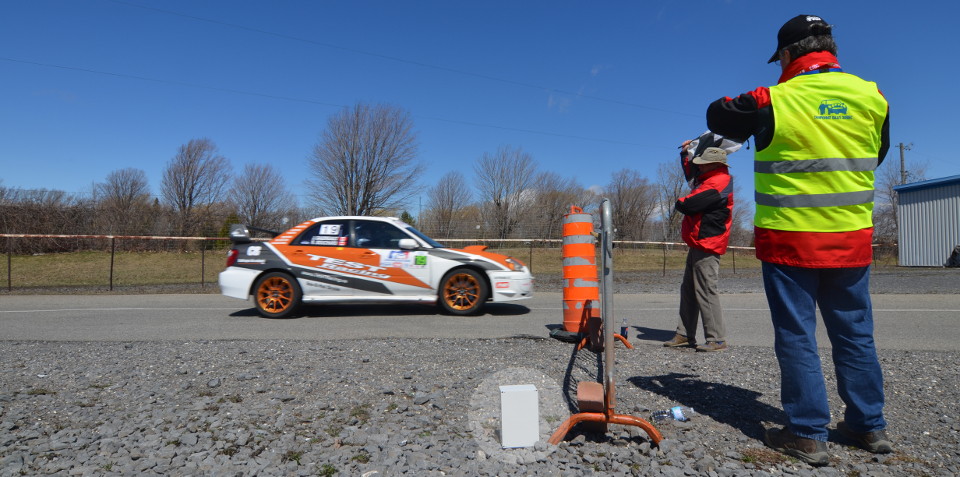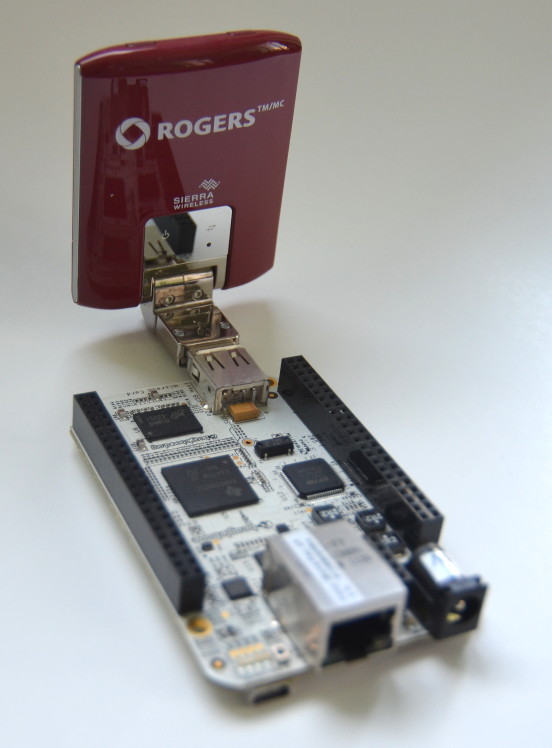
Imagine the following set of requirements: you need to identify and time cars at rally finishes, they’ll be travelling as fast as they can in any weather condition imaginable, often in remote areas. Oh, and you need to send the data to the Internet as well as make it available locally for the control marshal.
That’s exactly the challenge we faced last weekend at Rallye Sanair. Currently it takes at least three people to work a flying finish: one to whistle as the car passes, another to note the time of the whistle (see the photo above) and another to copy this time into the competitors’ route card. The little box you see in the photo can replace the two gentlemen: it detects an active RFID tag placed inside the car and communicates the identity in real-time over WiFi to a computer next to the third marshal. And in practice, it works great as long as there’s line-of-sight between the box and computer and the latter’s clock is synchronized with official rally time.
The problem, however, is Internet connectivity. Granted, Rallye Sanair has good cellular coverage unlike many Canadian rallies. But we were relying on a BYOD approach where the marshal’s computer would connect to the Internet via a cellular dongle. Terrific in theory yet problematic in practice. In short, it’s no fun troubleshooting someone else’s computer with spotty Internet while it’s raining sideways and your fingers are frozen. Let’s not even consider what that would be like on a remote winter rally! Ideally, the ‘box’ would function standalone: autonomously connecting to the Internet and synchronizing its own clock automatically. The information it collects could still be provided to the marshal by a local link.
So, how do you connect a ‘box’ to the Internet? Well, that’s exactly the challenge of the Internet of Things! Ideally there would be a ubiquitous wireless network where Things could economically communicate short messages (like car number, control number and timestamp) to the Internet. This actually exists in France right now where Sigfox has built just such a network. Neul is working on the same thing using television whitespace. But alas, for now, in North America at least, we must rely on the cellular carriers.
Given those constraints, here’s what we’ve come up with. Start with an economical Linux single-board computer like the BeagleBone (the soon-to-be-released BeagleBone Black costs only $45). Add a Sierra Wireless (now Netgear) AirCard 330U which can connect to several generations of cellular networks and which includes a GPS (clock synchronization solved!). Toss in a sealed lead-acid battery and a reelyActive reelceiver and enclose it in a weatherproof box. You have an all-in-one solution with an off-the-shelf BOM, and Rogers is kind enough to offer plans starting at $5/month (even for businesses).

A rally checkpoint in a box, awesome! But what’s the point? Many have pointed out that the tiny rally market will never sustain a profitable business. Absolutely true. However, the problem we’re solving is one of the most challenging among a large family of similar problems. Are all my workers and equipment present at the remote worksite? Did I leave behind an important tool from my truck, and where? How many bikes are at the bike share? What cars are in my parking lot and when did they arrive? Is my child at the playground? One Thing to reel them all.
What we’ve learned from rally is that accessible M2M (machine-to-machine) Internet connectivity remains a key blocker for many applications, but there are viable workarounds pending the establishment of a global, wireless network specifically designed for the Internet of Things.